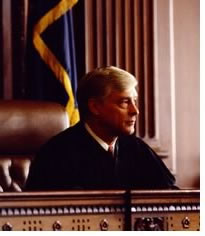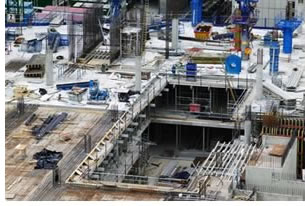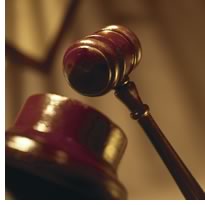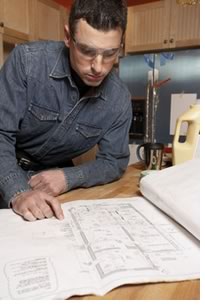

8/2006
Observations, inspections, and the contractor’s warranty

by Grant A. Simpson, FAIA, and James B. Atkins, FAIA
Building construction requires many workers and many trades. The contractors and subcontractors must coordinate and interface their work and plan how all the separate parts and pieces will fit together. A contractor coordinates the subcontractors and develops a work plan for delivering a completed project that conforms to the architect’s design.
 Because the contractor is solely responsible for conformance of work
with the contract documents, it must continuously inspect the work as
it goes in place to determine that subsequent work can be placed over
it, documenting minor variations for the owner’s information.
Because the contractor is solely responsible for conformance of work
with the contract documents, it must continuously inspect the work as
it goes in place to determine that subsequent work can be placed over
it, documenting minor variations for the owner’s information.
The architect observes the work at certain times during the construction phase, but on a much less frequent basis and for different purposes than the contractor. Architects are charged only with being generally familiar with the work and reporting the general progress and quality of the work, as completed, to the owner. The standard of care is that the architect should be responsible for discovering and reporting nonconforming work that is available to be seen, yet the profession has been affected by a trend that indicates an attitude of a much higher standard among owners and contractors. Many such claimants have asserted that the architect has a responsibility similar to that of the contractor and should discover any and all defects. These expectations can become so distorted that owners and contractors in some instances essentially have asserted that the architect should be a warrantor of all work placed by the contractor. This has increased the risks associated with the architect’s construction phase services, particularly the requirements for observing and inspecting the work.
Courts have ruled that architects failed to detect the contractor’s defective work, holding that they have a duty to endeavor to guard the owner against all non-conforming work on the project, although much of that work is installed when the architect is not present.
 This article will explore the issue of work conformance and the responsibility
for finding and preventing defective work. It will examine who is contractually
and physically responsible for work conformance, as well as the continuing
attempts by plaintiffs’ lawyers to hold the architect accountable
for this obligation.
This article will explore the issue of work conformance and the responsibility
for finding and preventing defective work. It will examine who is contractually
and physically responsible for work conformance, as well as the continuing
attempts by plaintiffs’ lawyers to hold the architect accountable
for this obligation.
The contractor’s obligation
First, we will examine the contractor’s obligation under the contract.
In AIA Document A201-1997, General Conditions
of the Contract for Construction (A201):
3.1.2 “The Contractor shall perform the Work in accordance with the Contract Documents . . . ”
This requirement is straightforward and absolute. There are no qualifications or overriding conditions that can alter or relieve this obligation. In fact, A201 states:
3.1.3 “The Contractor shall not be relieved of obligations to perform the Work in accordance with the Contract Documents either by activities or duties of the Architect . . . or by tests, inspections or approvals required or performed by persons other than the Contractor.”
In addition, A201 requires continuous inspection of work already in place, by the contractor:
3.3.3 “The Contractor shall be responsible for inspection of portions of Work already performed to determine that such portions are in proper condition to receive subsequent Work.”
The bottom line is that the contractor controls the work, the contractor is required to inspect the work for conformance, and the contractor contractually warrants the work to be free from defects. This responsibility is absolute, and it is not superseded by the architect’s observations, inspections, or approvals.
The architect’s standard of reasonable
care
The Architect’s Handbook of Professional Practice, 13th edition,
generally states on page 480 the “standard of reasonable care” as
follows:
“The architect is required to do what a reasonably prudent architect would do in the same community and in the same time frame, given the same or similar facts and circumstances”
The Architect’s Handbook of Professional Practice also addresses on page 480 matters that relate to the level of perfection that must be achieved in performing architectural services:
“The Architect’s Legal Responsibility: The law does not require perfection from an architect. As with any complicated human endeavor in which success depends on the exercise of reasoned judgment and skill, the law recognizes that perfection in architecture is a much-sought-after but rarely achieved, end.
. . . Accordingly, the law does not look to architects to guarantee, warrant, or otherwise ensure the results of their efforts . . .” (bold added)
and:
“Expectations of project participants . . . “Many clients do not understand that architects are neither able nor required to perform perfectly. Such clients have high expectations for their projects and want their design professionals to provide guarantees . . .
They may do so without understanding that architects, like lawyers and doctors, provide their clients with services, not products. They may also fail to realize that professional judgment is required at each step. Architects need to remind these participants that buildings, unlike automobiles, can’t be pretested, and that no amount of effort, care, and conscientiousness on the architect’s part can foresee every aspect of transforming a design on paper into reality.” (bold added)
The architect should be responsible for discovering and reporting defective work of which it becomes aware. However, expectations in the industry have risen above this level of duty, and today court pleadings are filled with allegations of absolute responsibility on the part of the architect.
 Defacto approval of defective work?
Defacto approval of defective work?
When the quality or conformance of the work is questioned, the assertion
is often made that the architect “approved,” “allowed,” or “permitted” the
contractor’s defective work by certifying an application for
payment, signing a change order, or certifying substantial completion.
Although the owner can accept nonconforming work if they so choose,
there is no provision contained within the AIA documents that allows
the architect to accept work that is not in conformance with the contract
documents. Moreover, in A201, the architect is empowered to reject
nonconforming work.
4.2.6 “The Architect will have authority to reject Work that does not conform to the Contract Documents.”
A201 clearly states that the architect’s certification of a payment application does not represent approval of the work.
9.6.6 “A Certificate for Payment . . . shall not constitute acceptance of Work not in accordance with the Contract Documents.”
This avenue of making claims overlooks several other important aspects of the provisions of the AIA documents, all of which are intended to prohibit the architect from accepting non-conforming work rather than place a finite obligation on the architect to detect non-conforming work.
A201 addresses defective work placed by the Contractor:
3.5.1 “The Contractor warrants to the Owner and Architect that . . . the Work will be free from defects not inherent in the quality required or permitted, and that the Work will conform to the requirements of the Contract Documents.” (bold added)
Here, the contractor provides an expressed warranty to both the owner and the architect that there will be no defective work on the project. Unfortunately, the contractor’s warranty to the architect, should the architect experience a loss caused by the contractor’s defective or nonconforming work, may be of little value if the contractor is bankrupt or no longer in business. Moreover, the architect not only does not provide such a warranty concerning the quality of the work, the architect has no responsibility for the contractor’s performance as indicated in A201.
4.2.3 “The architect will not be responsible for the Contractor’s failure to perform the Work in accordance with the requirements of the Contract Documents. The Architect will not have control over or charge of and will not be responsible for acts or omissions of the Contractor, Subcontractors, or their agents or employees, or any other persons or entities performing portions of the Work.”
So how is it that many have come to believe that the architect’s obligation to discover defects on a project is similar to, or even greater than the contractor’s guarantee that there will be none? Perhaps some derive this erroneous notion from the architect’s authority to reject non-conforming work of which the architect becomes aware as stated above in A201, and in AIA Document B141-1997 Part 2, Standard Form of Architect’s Services: Design and Contract Administration (B141):
2.6.2.5 “The Architect shall have authority to reject Work that does not conform to the Contract Documents.”
There is absolutely no obligation conferred in this paragraph to detect nonconforming work, only authority to reject it if discovered.
 Claiming in style
Claiming in style
Claims against architects are often styled to try to take advantage of
a particular state law or to put the design professional in as unflattering
position as possible. The following examples are styled after actual
claims filed against design professionals, and they are typical of
what a design professional may expect if an owner unhappy with the
quality of the work claims the architect should pay all or a portion
of the cost of remedying nonconforming work. In all of these examples,
the contract documents include the standard AIA contract language cited
in this article, found in B141 and A201. In addition, in all of these
examples the owner is claiming damages by the architect in the full
amount of the cost of remedying the non-conforming work placed by the
contractor and covered by the contractor’s warranty.
Catch me if you can: The plaintiff’s lawyers claimed as follows, admitting that the contractor did the work badly, but only because the architect did not catch them:
The roof drains are not installed properly; Scuppers are not installed properly; Gaps in the flashings exist; Pitch pans on the roof are not fully filled . . . The architect failed to document and report defective work.
In addition, this one also reflects a belief in the awesome power of the architect to “allow” the contractor to perform badly:
The contractor performed work well below acceptable industry standards, provided and installed inferior materials, failed to perform required testing . . . failed to adequately supervise work of the subcontractors. The architects failed to provide acceptable contract administration services by permitting substandard work and poor workmanship . . .
The director: Plaintiff’s lawyers also are fond of claiming that the architect should have been directing the work, as in this example:
Failure to properly perform construction administration responsibilities. Architect was responsible for poor sequencing among the various trades.
This claim was filed, although A201 clearly states in section 3.3 that directing and coordinating the work of the subcontractors—and construction sequences—are the contractor’s responsibility.
You bought the farm: Another favorite avenue of plaintiff’s lawyers for making claims against architects involves certifications for payment by the architect:
The contractor executed substandard and nonconforming work . . . by certifying the contractor's Applications for Payment that included costs for nonconforming work the Architect failed in his duties during the Contract Administration phase and failed in his responsibility to the owner.
Adult supervision: The assertion that the architect has a stronger duty than the contractor to supervise the work is evidenced by the following claim. This disingenuous allegation is so prevalent in lawsuits against architects these days that it could be viewed as generic:
At the time that contractor’s defective work was performed Architect was supervising the work at the site. Additionally, the work was performed while Architect was in charge of the work. This evidence creates a genuine issue as to whether Architect violated its contractual duty to “guard the Owner against defects and deficiencies in the Work.”
 Most expertly, if you please
Most expertly, if you please
Not only do plaintiffs’ lawyers make claims not supported by the
AIA documents or the standard of care, such claims are also made by plaintiffs’ experts.
The following style of “opinion” submitted by an “expert” is
also so prevalent that it could be considered generic as well:
. . . most, if not all, of the issues noted are the result of poor workmanship and nonconforming work performed by the contractor. These problems were exacerbated by the Architect's failure to observe nonconforming work, notify the owner, and require that the work be redone.
Once again, the claim acknowledges that the primary issue is poor workmanship and nonconforming work, but asserts that the architect should pay for the cost of remedying the problems because the architect did not catch the contractor’s poor performance.
None of these examples survives scrutiny when compared with the architect’s responsibilities as defined by the AIA documents, with a reasonable standard of care, or with any reasonable interpretation of who should be responsible for nonconforming work. It is physically impossible for an architect to witness and have knowledge of every component placed in a building. There is simply no reasonable or logical way to conclude, “. . . sure the contractor built it wrong, but it’s your fault because you let him do it . . .”
The architect “shall endeavor to guard”
Plaintiff’s lawyers often attempt to use a clause in B141 to place
the architect in the role of policing the contractor. The architect’s
obligation is as follows:
2.6.2.1 “The Architect, as a representative of the Owner, shall . . . endeavor to guard the Owner against defects and deficiencies in the Work . . . ” (bold added)
Merriam-Webster Dictionary defines “endeavor” as:
“ . . . to attempt (as the fulfillment of an obligation) by exertion of effort . . . ” (bold added)
The definition of endeavor is “to attempt to do,” “to try to do” . . . but there is neither absolute obligation nor overriding cause for the architect “to do,” such as there is with the contractor’s obligation to inspect continuously those portions of the work that are to receive subsequent work.
Rightfully, these clauses related to endeavoring to guard the owner against the contractor’s defective work must be balanced against the limited nature of the review of the work the architect is required to do when the architect visits the project site. This is addressed in B141 with almost identical wording in A201:
2.6.2.1 “The Architect . . . shall visit the site . . . (1) to become generally familiar with and to keep the Owner informed about the progress and quality of the portion of the Work completed . . . (3) to determine in general if the Work is being performed in a manner indicating that the Work, when fully completed, will be in accordance with the Contract Documents. However, the Architect shall not be required to make exhaustive or continuous on-site inspections to check the quality or quantity of the Work” (bold added).
Merriam-Webster Dictionary defines “generally” as:
“ . . . in disregard of specific instances and with regard to an overall picture...”
 Thus,
although the architect has authority to reject any non-conforming work
that is apparent, the architect does not have a duty to discover all
defective work. In fact, the expectation that an architect could discover
all defective work on a project is unrealistic due to the architect’s
limited presence on the site. Even when the architect provides a full-time
on-site project representative on larger projects, the representative’s
obligation in this regard is limited compared to the contractor. Architects
do have a duty to endeavor to guard the owner against defective work,
but this obligation is restricted by the limited duty to become generally
familiar with the work.
Thus,
although the architect has authority to reject any non-conforming work
that is apparent, the architect does not have a duty to discover all
defective work. In fact, the expectation that an architect could discover
all defective work on a project is unrealistic due to the architect’s
limited presence on the site. Even when the architect provides a full-time
on-site project representative on larger projects, the representative’s
obligation in this regard is limited compared to the contractor. Architects
do have a duty to endeavor to guard the owner against defective work,
but this obligation is restricted by the limited duty to become generally
familiar with the work.
The AIA documents and the standard of care are clear that the contractor’s obligation and responsibility to install competent and conforming work are not overridden by placing a stronger responsibility on the architect to “catch” him if he does not. In the absence of a specific contract requirement, the architect is not an insurer, ensurer, guarantor, or warrantor of the contractor’s performance. No architect possessed of sanity would agree to such a provision in a contract, and it is not the intent of the AIA documents or the standard of care to place such a responsibility on the architect.
Performance and Payment Bond
Some owners undoubtedly desire that faithful performance of all parties
involved in designing and constructing their projects be covered by
some form of insurance. One such avenue is a performance and payment
bond. Under ordinary circumstances, the owner has the right to require
that the contractor assure its performance by requiring a Performance
and Payment Bond as described in A201.
11.5.1 “The Owner shall have the right to require the Contractor to furnish bonds covering faithful performance of the Contract and payment of obligations arising thereunder as stipulated in bidding requirements or specifically required in the Contract Documents on the date of execution of the Contract.”
In traditional project delivery, there is no such requirement in the AIA documents or in industry practice for the architect to provide a bond covering the contractor’s faithful performance, and we are not aware of an instance where an architect has provided such assurance through either a contract or a bond.
If owners want a financial guarantee of the contractor’s faithful performance, that protection should rightfully be purchased through the contractor and not pursued indirectly through the architect’s professional liability insurance policy.
 Absolute power
Absolute power
The contractor has well defined responsibilities and obligations to ensure that
the work does conform to the requirements of the contract documents,
including supervising the work and providing a “warranty” to
the owner and the architect, as cited in the paragraphs above. The
primary reason that the contractor makes a warranty to the architect
is that the architect can never be in the position of observing all
of the work of the contractor, subcontractors, and other parties performing
the work. It would literally require an army of architects continuously
present on the site to see all of the work at every stage of the work.
Professional service of that sort would certainly be considered exhaustive
or continuous on-site inspections, if not direction and supervision.
Merriam Webster defines supervision as:
“the action, process, or occupation of supervising; especially: a critical watching and directing (as of activities or a course of action)”
The architect does not supervise or direct the contractor or the work. The responsibility for supervising and directing the work rests solely with the contractor. A201 is very explicit about these responsibilities:
3.3.1: “The Contractor shall supervise and direct the Work using the Contractor’s best skill and attention. The Contractor shall be solely responsible for and have control over construction means, methods, techniques, sequences and procedures and for coordinating all portions of the Work under the Contract . . .”
And,
3.3.2: “The Contractor shall be responsible to the Owner for the acts and omissions of the Contractor’s employees, Subcontractors and their agents and employees, and other persons or entities performing portions of the Work for or on behalf of the Contractor any of its Subcontractors.”
In addition, we have already seen that 3.3.3 requires the contractor to continuously inspect the work in progress.
Affirmation
The issue of observing the work and detecting and reporting deficiencies
is fraught with risks, as we have enthusiastically put forth. However,
all of the above not withstanding, an architect can be found responsible
for failing to “endeavor to guard” as in the example where
site visits and observations are made, and defective work readily available
to be observed is not cited or reported. Challenging inequities do
not absolve the architect from performing in accordance with a reasonable
standard of care. While the architect should not be required or expected
to warrant the contractor’s work, the architect’s contracted
duties during the construction phase should be taken seriously and
performed appropriately.
Absolution
AIA Document A201 clearly states that the contractor is solely responsible
for the work. The contractor controls every aspect of the work. This
control includes final decisions about which materials and product
vendors will be used. They determine how the work is to be installed
and how the work installation is to be divided and coordinated between
subcontractors. Moreover, perhaps the contractor’s most important
responsibility is the obligation to make sure the work conforms to
the contract documents. The contractor provides an express warranty
to both the owner and the architect that the work will be in conformance
with the design concept expressed in the contract documents.
 The
architect interprets the contract drawings and reviews the contractor’s
submittals, coordination drawings, and clarification sketches, which
anticipate the finished project, for conformance with the design concept.
The architect observes the work to form general opinions about progress
and quality and reports the status to the owner. At no time does the
architect approve the work in its totality. There is no reasonable way
that the architect can see each piece of material as it goes into the
project. Only the contractor is in a position to provide that service.
Substantial completion is “substantial” but not “total.”
Final completion is the correction of known, but not necessarily all,
items that require correction or completion.
The
architect interprets the contract drawings and reviews the contractor’s
submittals, coordination drawings, and clarification sketches, which
anticipate the finished project, for conformance with the design concept.
The architect observes the work to form general opinions about progress
and quality and reports the status to the owner. At no time does the
architect approve the work in its totality. There is no reasonable way
that the architect can see each piece of material as it goes into the
project. Only the contractor is in a position to provide that service.
Substantial completion is “substantial” but not “total.”
Final completion is the correction of known, but not necessarily all,
items that require correction or completion.
The architect’s certification of the contractor’s applications for payment is based on the general progress of the observed work and the contractor’s notarized certification that the application is accurate and consistent with the work progress.
The architect and the owner must rely on the contractor’s written guarantee that the work is in conformance. According to A201, this obligation withstands all actions of the architect, including observations, inspections, submittal approvals, and payment certifications. This absolute power of the contractor to control and be responsible for the work is never shared, assigned, or assumed by any other party.
By contrast, architects have no authority over subcontractors. They have no power over construction, and they have no obligation or duty to warrant that the contractor’s work is free from defects and deficiencies or is in strict conformance to the contract documents. The architect’s obligation is to endeavor to guard the owner against defects and deficiencies in the work and means nothing more. The premise that “guarding the owner” includes detailed knowledge of every building component is not only unachievable; it runs counter to the contractor’s “sole responsibility” and the warranty that backs it up.
Administering the construction contract provides valuable services to the owner, and it increases the chances of preserving the design concept. It also gives the architect a chance to address errors and omissions hopefully before the work is installed. However, observing and inspecting the work absolutely brings risks that may not result in absolution, and we must be mindful of the claims owners, their lawyers, and contractors sometimes make regarding the ways they believe the architect should be an insurer, supervisor, director, and guarantor of the contractor’s work.
And as you go along the way, watch where you step, keep a lookout overhead, and be sure to be careful out there.
Copyright 2006 The American Institute of Architects.
All rights reserved. Home Page ![]()
![]()
This article is excerpted with permission from the May/June 2006 edition of Texas Architect. Copyright © 2006 by the Texas Society of Architects.
If you would like to ask Jim and Grant a risk or project management question, or request them to address a particular topic, contact them through AIArchitect.
James B. Atkins, FAIA, is a principal with HKS Architects. He serves on the AIA Documents Committee and he is the 2006 Chair of the AIA Risk Management Committee.
Grant A. Simpson, FAIA, manages project delivery for RTKL Associates. He is the 2006 Chair of the AIA Practice Management Advisory Group.
This article represents the opinions of the authors and not necessarily that of The American Institute of Architects. It is intended for general information purposes only and does not constitute legal advice. The reader should consult with legal counsel to determine how laws, suggestions, and illustrations apply to specific situations.
![]()